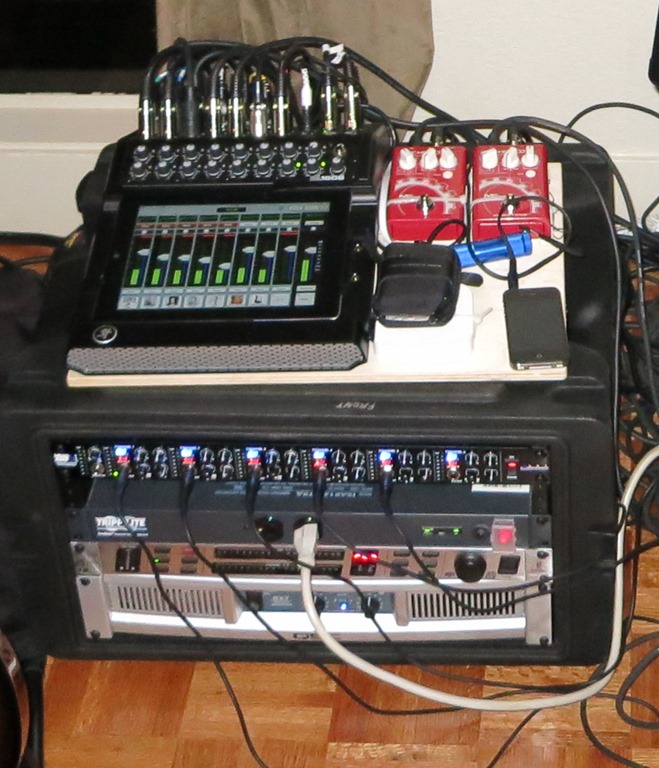In-Ear Game Changer
We’ve decided to take the plunge and switch to in-ear monitoring. This is a big change, but I’m super-excited about it.
In my recent post about overhauling our PA with my band The Drop Daddies, I mentioned that our new DL1608 mixer has 6 independent aux outs- perfect for individual monitor mixes.
But running monitor wedges on stage has a number of issues:
- they take up a lot of floor space- always at a premium on stage
- they are loud and bleed into the mics. Managing stage volume is key to avoiding a muddy live sound.
- we end up having to wear ear plugs to protect our ears from the noise, but then it’s hard to hear what we need to perform well
In-ear monitors would solve all these issues. But I hadn’t really considered them before because in-ear monitor systems are crazy expensive, right? Wrong!
Here’s my inexpensive solution: forget wireless and just run wired in-ears, and use off-the-shelf in-ears instead of custom-molded. My shopping list:
- ART HeadAmp6 Pro
- 6 x Shure SE215
- 6 x Bud Buttons
- 6 x ProCo 20ft 1/4” TRS Male to 1/8″ Mini Female Cable
- And for the guitars:
Wireless is expensive, and would be complicated with six separate transmitter/receiver units for six independent mixes. At first we bought a couple Rolls PM55P to try out (with the the theory of putting them on our pedalboards, etc), but we had some hum issues that we couldn’t resolve, so we returned them. Instead, we bought a 6-channel headphone amp, the ART HeadAmp6, which turns out to be a much better solution anyway. We also needed six long 1/4” male to 1/8” mini female extension cables.
For the in-ears, we chose the single driver Shure SE215’s. These are only $99, fit well, sound fantastic, and have amazing sound-isolation. The clear version looks fairly innocuous, and lays flat in the ear. They block out the sound of the drums/cymbals and amps really well, allowing us to have the monitoring volume in our ears much lower for a nice clear mix, and no ringing in our ears after rehearsals/gigs.
 We run the SE215 wires from the ear-pieces back behind our necks, and clip them to our shirt so they don’t pull out. We’re using these magnetic Bud Buttons, which work reasonably well, but if your shirt is too thick the magnet doesn’t work so well. We may need to look into a simpler, mechanical clip instead.
We run the SE215 wires from the ear-pieces back behind our necks, and clip them to our shirt so they don’t pull out. We’re using these magnetic Bud Buttons, which work reasonably well, but if your shirt is too thick the magnet doesn’t work so well. We may need to look into a simpler, mechanical clip instead.
In practice, the extension wires aren’t a problem at all. I bought a 1/8″ to 1/8″ extension cable the same length as my guitar cable, and spiral wrapped them together. (I used this 10mm flexible black polyethylene cable wrap). I connect that to the long lead from the headphone amp right at my pedal board where I plug in my guitar. So the female headphone jack is right at my waist, looped through my guitar strap, where I can plug in my SE215’s. Perfect.
 This has been a total game changer – being able to hear your guitar and voice clearly allows you to focus on a better more nuanced performance. Maybe some day we’ll switch to wireless and buy custom-molded in-ears, but for now this totally works.
This has been a total game changer – being able to hear your guitar and voice clearly allows you to focus on a better more nuanced performance. Maybe some day we’ll switch to wireless and buy custom-molded in-ears, but for now this totally works.



Filling In The Spaces - Planet Z
April 3, 2017 @ 7:49 am
[…] In-Ear Game Changer […]
SKB Rolling Rack Broken Foot – Planet Z
April 27, 2017 @ 9:08 pm
[…] use a 6-space SKB Rolling Rack Case to contain our Mackie DL32R mixer, power amp, headphone amp, and feedback […]
Helix vs Blackstar – Planet Z
May 2, 2017 @ 10:24 pm
[…] Board preset – and then took it to rehearsal this morning with the band. We were playing with in-ears as usual, but now with my Helix running direct into our DL32R mixer, instead of mic’ing the […]
ART Headphone Amp Repair – Planet Z
April 18, 2018 @ 6:14 pm
[…] using the ART HeadAmp6 6-channel Headphone Amp in my band for a few years, and it’s always worked like a champ. A while back however, the front panel lights began flickering disconcertingly and we were hearing […]